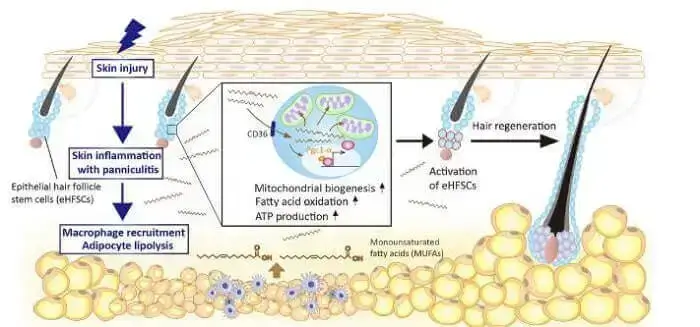
An interesting new hair loss related study was published two days ago, with the lengthy title below limiting its virality:
It was also covered in New Scientist, but hidden behind a paywall. The key phenomena behind hair regrowth that were discussed in the study entail skin injury, adipocytes (fat cells) and fatty acids. But the New Scientist article title focused on the skin irritation aspect.
Note that I have discussed the concept of skin injury (or intentional wounding) and hair growth numerous times on this blog, especially related to now defunct Follica. Also check out my post on at-home microneedling for hair growth. I have also written many posts on fat cells and adipocyte-derived stem cells in relation to hair growth.
Skin Injury, Adipocyte Lipolysis and Hair Growth
No-one paid attention to the above mentioned new study till today. As is so often the case, this is due to coverage by the widely read Daily Mail in a catchy title that suggests a hair loss cure in 20 days. To be fair, they do mention in the title that it was in mice.
- Spurred to do further research, I then realized that I had covered the lead author of this new study (Dr. Sung-Jan Lin of National Taiwan University) in a 2020 update to my post on the arrector piil muscle.
- Moreover, all the way back in 2014, I covered Taiwan National University Hospital’s study on hair cloning (under the leadership of the same Dr. Sung-Jan Lin).
- Even more interesting, one of the co-authors of this study is the renowned hair loss researcher Dr. Maxim Plikus. Giving it all the more legitimacy.
Getting back to the study, the scientists induced eczema (aka the injury or irritation) on shaved mice of both sexes. They did this by applying a chemical irritant called sodium dodecyl sulfate (SDS) to their backs. Lo and behold, in 11 days, the treated areas of skin started to sprout new hair from follicles that are just a fraction of a millimeter wide. At the same time, hair didn’t regrow on the areas of the mice without eczema. The hair also didn’t grow in other shaved mice that were never treated with SDS.
The researchers found that the irritant causes immune cells to move into the layer of fat beneath a mouse’s skin. This in turn signals fat cells (adipocytes) to release fatty acids which are then absorbed by hair follicle stem cells. Ultimately triggering hair growth. The intentional injury triggers adipocyte lipolysis, which in turn activates epithelial stem cells for hair regeneration through fatty acid metabolic signaling.
A new Fatty Acid base Serum for Treating Hair Loss
The most interesting part is what the researchers did next. They tested various monounsaturated fatty acids (MUFAs) on skin without the use of any chemical irritant. They created rub-on serums made of different fatty acids (such as oleic acids and palmitoleic acids) dissolved in alcohol. To my surprise, the researchers found that these fatty acids were effective in promoting hair regeneration, even when applied to the skin without any preceding irritant.
They have patented their serum and now plan to test different dosages of it on people’s scalps. Since oleic acids and palmitoleic acids are naturally derived fatty acids, they are safe and side effect free. No clinical trials will be required to sell this product as a hair loss cosmetic.
The Taiwanese team is already seeing promising results when applying it to human hair follicles in their lab. And Mr. Lin applied it to his thighs and gave the following quote:
“I personally applied these fatty acids, dissolved in alcohol, on my thighs for three weeks and I found it promoted hair regrowth”
Of course my gut feeling based on over 12 years of writing this blog is that this will not translate into any significant scalp hair regrowth in humans. Perhaps some minor hair thickening, as can be seen when using the best hair loss shampoos, some of which even contain plant-derived oleic acids and palmitoleic acids.